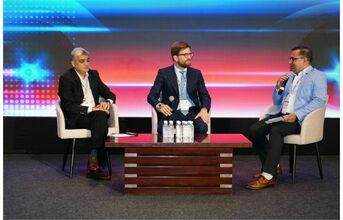
Ramani asked Christopher about the influences on his organisation's sustainability strategy for raw materials, questioning whether it is solely driven by OEMs or is also shaped by external factors like government and societal expectations.
Stillings responded, stating that initially, the sustainability initiative originated within the organisation. However, he noted that in the current landscape, external factors such as regulations and market pressures significantly contribute to the sustainability drive. He highlighted that the organisation was among the early adopters in expressing the ambition to achieve full circularity, especially in the energy-intensive chemical industry, acknowledging the associated challenges and consequences.
Further, he pointed out that to create a positive impact in terms of CO2 emissions or climate neutrality, designers play a major role; they need to think ahead and come up with new product designs.
He also disclosed that over time, Covestro will be seen switching all its plants in a direction where they run on renewable energy, along with increasing the use of alternative raw materials. Furthermore, substantial investments are being made in chemical recycling, presenting a promising avenue for attaining a set of material properties comparable to those in the current production value chain at a later stage.
Posing a question to Sanjay, Ramani asked him about the process of navigating conflicting requirements for designing the same product for a single vehicle across different geographies, considering varying government incentives and regulations, while maintaining consistent design.
From the viewpoint of a Global Programme Director, Khare explained that the global programme is undertaken by OEMs primarily due to the economic advantages gained through economies of scale. However, this often necessitates compromises at different levels. In the context of India, it is observed that global programmes are frequently shared with Brazil and Russia.
The considerations revolve around what is locally accessible. The modular design is a key factor, and decisions are influenced by factors such as local availability, material, cost structures, and adherence to local regulations.
Although the overall design may be consistent, there are instances where compromises are made based on specific local requirements, material availability, and cost structures. While certain components, like seats or the instrument panel design, may be standardised, there are often necessary adjustments to accommodate local factors.
In terms of cost-effectiveness, he explained that India is consistently positioned on the lower cost side when comparisons are made. Brazil, on the other hand, tends to be more expensive, making India the more economical choice. However, he noted that the situation has evolved, especially in global programmes where specific and well-defined targets have been set.
If you set a cost target from the outset and effectively manage the entire programme from inception to end-of-life, incorporating all relevant factors, it becomes a manageable task. However, the ongoing challenge for India persists, as it continues to be perceived as a low-cost country. Despite this, there is a need to dispel the misconception that all resources and raw materials are readily available domestically.
Continue Reading on Page 4


























